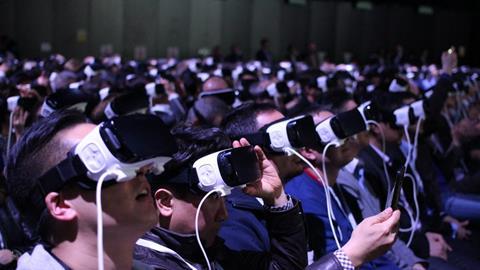A truly immersive VR journey for the senses uses haptic technology to replicate the likeness of touch and feel for the ultimate VR experience, writes Amelia Kallman.

In the trailer for Steven Spielberg’s upcoming movie, Ready Player One, people wear headsets, gloves and bodysuits to enter the virtual reality (VR) world of The Oasis.
While we can hope that the film’s dystopian vision of the future isn’t accurate, it’s definitely right about one thing: VR headsets are not enough.
In order to create more immersive, impactful, and entertaining experiences that will reach the widest audience, VR needs to integrate and utilise the richness of haptic technology.
Haptic technology is the use of forces and vibrations to replicate the sense of touch, allowing you to virtually feel things that aren’t really there, like shapes, objects, textures, weight, and temperature.
What’s more human than the sense of touch?
We use it so often that it’s easy to take for granted. That is, until you’re in a virtual world and reach out to touch something and you can’t, returning you suddenly to reality and removing belief in the illusion of the digital world.
“Haptics is key to making experiences compelling and stimulating enough to get people excited”
But all this is starting to change.
Haptics is the missing piece of the puzzle as far as the mainstream adoption of virtual reality goes. By adding this next level of sensory interaction we engage more parts of the brain, tricking it that much more.
By combining auditory, visual and touch senses we can increase the amount of time that feels comfortable to spend in VR, as well as provide new opportunities and possibilities for riveting storytelling and entertainment, perhaps even opening up whole new areas for creativity that haven’t even been discovered yet.
While the global virtual reality industry is projected to turn over revenues of $7.2 billion this year according to a recent Greenlight Insights report, the haptics industry, still considered to be in its infancy, is projected to be worth $19.55 billion within five years.
Earlier this year at the Consumer Electronics Show the rise of haptics alongside virtual and mixed reality content was clearly evident and widely regarded as the next phase of evolution for virtual experiences.
GoTouchVR is a wearable device worn on fingertips that syncs with VR games to provide haptic feedback when touching buttons, picking up objects, and playing instruments. With another finger wearable, Tactai Touch, one can not only reach out and touch a teddy bear, but also can feel the distinguishable textures of the fur, glass eyes, and leather nose.
At Georgia Tech they have even found that by using haptics gloves they can teach someone how to play the piano in under an hour, accelerating the learning process by combining muscle memory with sound, and active and passive learning.
Bristol-based Ultrahaptics doesn’t require a wearable at all.
Using ultrasound technology to project sensations onto a hand one can touch virtual objects in mid-air. In their VR demo audiences were delighted to feel zaps of lightning, a mist of rain, the heat of fire, and bubbles blowing, all without touching anything physically.
In immersive entertainment experiences we have in real life, like rock concerts, cinema, and theatre, we don’t just see and hear what’s happening, we feel it in our bodies too.
This sensation is caused by infrasonic frequencies, or low frequency sound waves that aren’t heard but felt, resonating through our bodies in a way one can only get by being in the room - until now.
Last week in Bristol, startup Substrike introduced the prototype for a new kind of music experience.
Founder Dr Nick Inoue debuted a comfortable lounge chair (pictured below) with a footrest that is able to deliver infrasonic frequencies directly to the body through haptic technology.

Substrike makes it easy to imagine a near future where we can augment a range of experiences in home, as well as in public arenas, that add an extra layer of authenticity and emotion to entertainment.
It also opens up new areas for creativity, from designing the scores of television, film, and VR to incorporate sub-frequencies, to playing with directional vibrations and personalisation of frequency preferences.
Based in the Netherlands, Sensiks produces ‘sensory reality pods’, small experience cabins that synchronise audio-visual virtual experiences with scent, temperature, airflow, tremble, taste and light frequencies.
The cabins can also use biometric data and artificial intelligence to recognise users and suggest content based on the collected personal data, resulting in more profound and intense interactions.
As virtual reality becomes more social, haptics can bring people closer even when far apart.
London design studio, The F-T-R, have created a remote touch interface that can let you shake someone’s hand on the other side of the world.
And VR porn enthusiasts are embracing haptic exoskeletons for their lifelike ability to simulate intimacy, which is known as ‘teledildonics’.
Haptics is proving to make virtual reality more human, more emotional, and more entertaining.
While virtual reality is great for experiencing things that you wouldn’t normally be able to do in real life, haptics is key to making those experiences compelling and stimulating enough to get people excited and keep them coming back for more.
Amelia Kallman is a futurist, speaker, journalist, author, nightclub owner and director of the first virtual reality burlesque show






















No comments yet